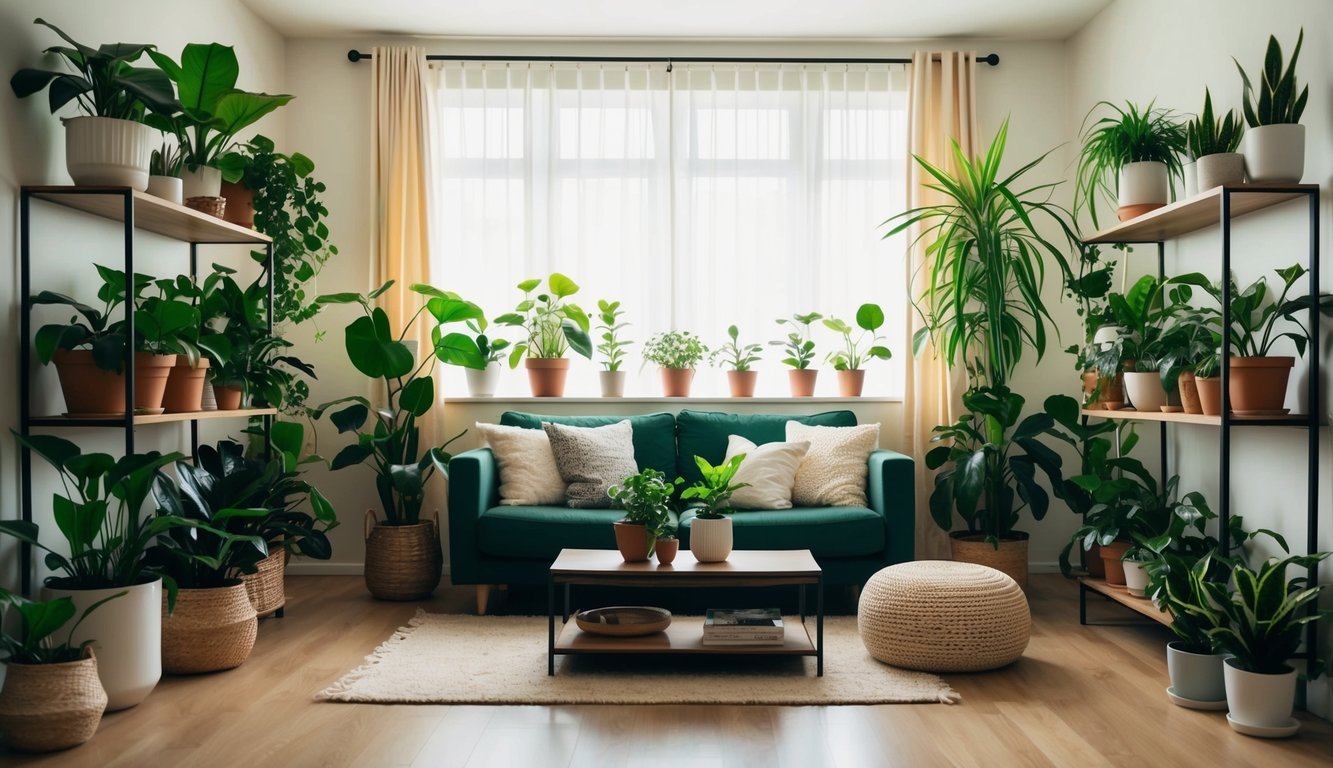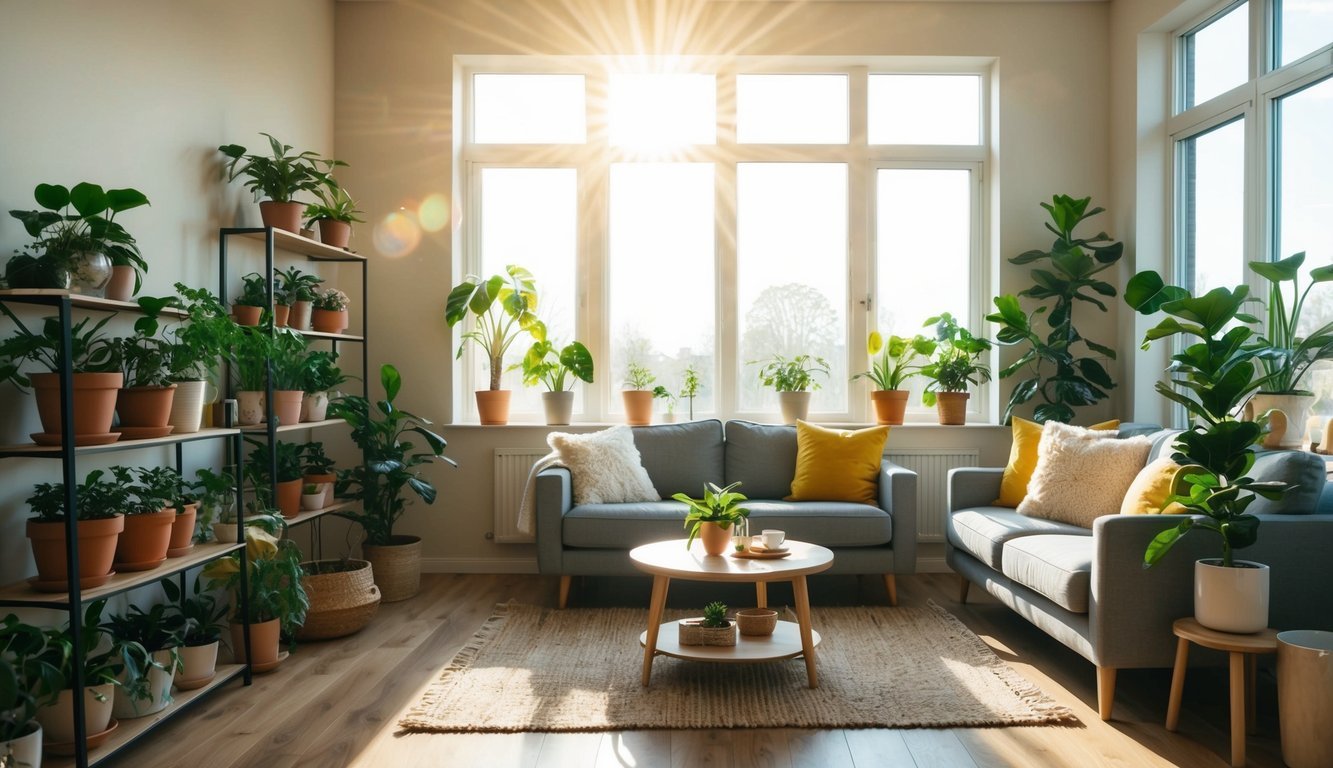Creating an indoor garden can be a rewarding experience, especially for those of us who want to bring some greenery into our homes without a huge commitment. I’ve discovered that cultivating a beautiful space with minimal effort is completely possible. You don’t need a green thumb or hours of spare time to enjoy the benefits of indoor plants.

In this article, I’ll share five simple steps to help you establish a low-care indoor garden.
Whether you’re starting with just a few pots on a windowsill or planning to fill a room with life, these tips will help make your gardening journey stress-free and enjoyable.
1) Choose easy-care plants
When I start my indoor garden, I always look for plants that are low-maintenance.
This makes it easier for me to enjoy the beauty of greenery without feeling overwhelmed.
One of my favorites is the monstera deliciosa, or Swiss cheese plant.
Its big leaves add a nice touch, and it tolerates low light and infrequent watering.
Another great option is the peace lily.
It can handle a bit of neglect when it comes to watering, which is perfect for busy days.
I also love the Zebra plant because of its striking leaves.
It’s beautiful and doesn’t demand too much care.
Choosing the right plants really helps.
I want my indoor space to feel vibrant without the stress of constant upkeep.
Easy-care plants make that possible.
2) Use a quality potting mix
Choosing a quality potting mix is key to a successful low-care indoor garden.
I find that the right soil can make a big difference in how my plants thrive.
I prefer a mix that includes compost or worm castings for nutrients.
This provides a solid foundation for healthy growth.
A good balance of coco coir and peat moss helps retain moisture without drowning the roots.
I also like to add some perlite or vermiculite for better drainage.
This mix creates a breathable environment that encourages root development.
It’s crucial to avoid compacting the soil too much when potting.
After transplanting, I always make sure to water thoroughly.
This helps settle the soil and ensures good contact with the roots.
Experimenting with ingredients can lead to great results.
Trust me, finding the right mix makes gardening a lot more enjoyable.
3) Pick the right containers
Choosing the right containers is essential for a low-care indoor garden.
I like to look for pots that have proper drainage holes.
This feature prevents root rot and helps my plants thrive.
I enjoy experimenting with different materials, like ceramic or terracotta.
These add style and character to my space.
Mixing size and shape can also create a visually appealing arrangement.
When selecting containers, I make sure they are the right size for my plants.
Too small can stunt growth, while too large may lead to excess moisture retention.
I often opt for medium-sized pots to start, which provides a good balance.
It’s also fun to repurpose containers.
Old jars or even stylish baskets can be great for planting.
Just ensure that whatever I use allows for drainage to keep my plants happy.
4) Ensure proper lighting
Getting the lighting right is crucial for my indoor garden.
Different plants have unique light requirements, so I pay attention to what each type needs.
For low-light plants, like snake plants or pothos, I often put them in spots that get indirect light.
This way, they thrive without needing constant exposure to bright sunlight.
If I have plants that need more light, I consider using artificial lights.
LED grow lights are a great option since they’re energy-efficient and effective.
Creating a light schedule helps too.
I try to ensure my plants get the right amount of light each day.
Some prefer long days, while others are good with fewer hours.
Checking the placement of my plants is also essential.
A south-facing window can boost sunlight exposure.
I adjust as needed to keep my indoor garden healthy and happy.
5) Maintain a watering schedule

Establishing a consistent watering schedule is essential for my indoor garden.
I usually check my plants every week to see if they need water.
This simple routine helps me avoid over or under-watering.
I’ve found that using room-temperature water works best.
It keeps my plants from experiencing shock, which can cause stress.
I aim for a temperature around 20°C to 22°C.
Bottom watering is another method I love.
I place my pots in a shallow basin of water, allowing the soil to absorb moisture from below.
This technique ensures the roots get hydrated while preventing compacted topsoil.
Environmental factors, like light and humidity, also play a role in how often I need to water.
Plants in bright, warm areas tend to dry out faster, so I pay extra attention to those.
If I forget my routine, I rely on a simple test.
I stick my finger into the soil; if it feels dry an inch down, it’s time to water.
This easy check keeps my plants happy and thriving with minimal fuss.
Choosing the Right Plants

Selecting the right plants is crucial for a low-care indoor garden.
I focus on two main aspects: choosing plants that thrive in low light and considering their size in relation to the space available.
Low-Light Tolerant Plants
Certain plants excel in low-light conditions, making them perfect for my indoor space.
A few varieties I often rely on include:
- ZZ Plant (Zamioculcas zamiifolia): Known for its glossy leaves, it requires very little light and moisture.
- Snake Plant (Sansevieria): This hardy option can tolerate neglect and thrives in indirect light.
- Pothos (Epipremnum aureum): Adaptable and trailing, it’s ideal for shelves or cascading from pots.
These plants not only survive but also add a touch of greenery to my home.
They help me maintain a relaxed atmosphere without needing constant attention.
Size and Space Considerations
Before I start choosing plants, I evaluate the size of my space.
It helps avoid overcrowding.
Here’s what I think about:
-
Small Plants: I often select smaller varieties like baby spider plants or small succulents for compact areas. They fit easily on desks or windowsills.
-
Medium to Large Plants: For bigger spaces, I go for peace lilies or fiddle leaf figs. They act as statement pieces, drawing the eye.
Understanding the height and spread of each plant helps me arrange them effectively.
This consideration not only enhances aesthetics but also ensures that they all have sufficient light and air.
Optimal Lighting and Placement

Getting the right light and placement can make or break your low-care indoor garden.
It’s essential to understand the types of lighting options and the ideal locations for your plants.
Natural Light vs. Artificial Light
Natural light is often the best option for indoor plants.
I usually place my greenery in spots that receive bright, indirect sunlight, like near north-facing windows.
These locations provide enough light without overwhelming the plants.
If natural light is scarce, I turn to artificial lighting.
LED grow lights are my go-to because they are energy-efficient and replicate sunlight.
When using these, I ensure they emit the right spectrum for plant growth.
The recommended range for low-light plants is about 50-150 μmol m²s⁻¹.
Best Spots for Indoor Plants
Finding the perfect spot for your plants can be tricky but rewarding.
Direct sunlight can scorch delicate leaves, so I typically avoid it.
Instead, I look for:
- North-facing windows: These provide low, indirect light.
- East-facing windows: These get gentle morning sun.
- Shady corners: These are perfect for low-light lovers like snake plants.
Many plants thrive in stable temperatures, so you should keep drafts and cold areas away from them.
I also ensure good air circulation around my plants.
That helps prevent mold and keeps them healthy.

